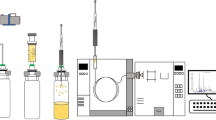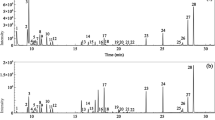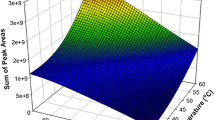Abstract
The stir bar sorptive extraction (SBSE) techniques, coupled with gas chromatography–mass spectrometry, were successfully applied to the study of Eucalyptus honey’s for the determination of volatile organic compounds (VOCs). An optimization of the extraction method was carried out and the variables, NaCl concentration (used as matrix modifier), and the concentration of honey solution were studied targeting the whole VOCs composition. After the evaluation of the experiments, the best condition for the extraction of honey volatile components was 2 mol/L of NaCl and the more concentrated honey solution (0.5 g of honey per mL of water). Additionally, the results were compared with those obtained by two headspace (HS) techniques, namely solid-phase microextraction (SPME) and dynamic headspace (DHS). SBSE volatiles differ qualitatively and quantitatively from those obtained by the SPME and DHS methods. In any event, the chemical composition of Eucalyptus honey volatiles extracted by all three techniques shows the presence of some typical floral markers. Our results confirm a general trend reported in the literature, which show the higher sensitivity of SBSE in the extraction of less volatile compounds in comparison with HS methods.


Similar content being viewed by others
References
Cuevas-Glory LF, Pino JA, Santiago LS, Sauri-Duch E (2007) A review of volatile analytical methods for determining the botanical origin of honey. Food Chem 103:1032–1043
Petretto GL, Cossu M, Alamanni MC (2015) Phenolic content, antioxidant and physico-chemical properties of Sardinian monofloral honeys. Int J Food Sci Technol 50:482–491
Floris I, Satta A, Ruiu L (2007) Honeys from Sardinia (Italy). J Apic Res 46:198–209
Ciulu M, Spano M, Pilo MI, Sanna G (2016) Recent advances in the analysis of phenolic compounds in unifloral honeys. Molecules 21:451. doi:10.3390/molecules21040451
Karabagias IK, Badeka A, Kontakos S, Karabournioti S, Kontominas MG (2014) Characterisation and classification of Greek pine honeys according to their geographical origin based on volatiles, physicochemical parameters and chemometrics. Food Chem 146:548–557
Manyi-Loh C, Ndip RN, Clarke AM (2011) Volatile compounds in honey: a review on their involvement in aroma, botanical origin determination and potential biomedical activities. Int J Mol Sci 12:9514–9532
Petretto GL, Tuberoso CIG, Vlahopoulou G, Atzei A, Mannu A, Zrira S, Pintore G (2016) Volatiles, color characteristics and other physico-chemical parameters of commercial moroccan honeys. Nat Prod Res 30:286–292
Soria AC, Martínez-Castro I, Sanz J (2008) Some aspects of dynamic headspace analysis of volatile components in honey. Food Res Int 41:838–848
Camino-Sanchez FJ, Rodriguez-Gomez R, Zafra-Gomez A, Santos-Fandila A, Vilchez JL (2014) Stir bar sorptive extraction: recent applications, limitations and future trends. Talanta 130:388–399
David F, Sandra P (2007) Stir bar sorptive extraction for trace analysis. J Chromatogr A 1152:54–69
Urgeghe PP, Piga C, Addis M, Di Salvo R, Piredda G, Scintu MF, Wolf IV, Sanna G (2012) SPME/GC–MS characterization of the volatile fraction of an Italian PDO sheep cheese to prevent lypolitic ripening: the case of Fiore Sardo. Food Anal Method 5:723–730
Kawaguchi M, Ito R, Nakazawa H, Takatsu A (2013) Applications of stir-bar sorptive extraction to food analysis. Trac-Trend Anal Chem 45:280–293
Bianchin JN, Nardini G, Merib J, Neves Dias A, Martendal E, Carasek E (2014) Screening of volatile compounds in honey using a new sampling strategy combining multiple extraction temperatures in a single assay by HS-SPME–GC–MS. Food Chem 145:1061–1065
Bianchi F, Careri M, Musci M (2005) Volatile norisoprenoids as markers of botanical origin of Sardinian strawberry-tree (Arbutus unedo L.) honey: characterisation of aroma compounds by dynamic headspace extraction and gas chromatography–mass spectrometry. Food Chem 89:527–532
Kus PM, Marijanovic Z, Jerkovic I (2013) Headspace compounds from Centaurea cyanus L. Honey: the occurrence of 3,4-dihydro-3-oxoedulan. Chem Nat Compd 49:961–964
Florencio Nogueira JM (2015) Stir-bar sorptive extraction: 15 year making sample preparation more enviroment-friendly. Trac-Trend Anal Chem 71:214–223
Bicchi C, Liberto E, Matteodo M, Sgorbini B, Mondello L, d’Acampora Zellner B, Costa R, Rubiolo P (2008) Quantitative analysis of essential oils: a complex task. Flavour Fragr J 23:382–391
Petretto GL, Sarais G, Maldini MT, Foddai M, Tirillni B, Rourke JP, Chessa M, Pintore G (2016) Citrus monstruosa discrimination among several Citrus species by multivariate analysis of volatiles: a metabolomic approach. J Food Process Preserv. doi:10.1111/jfpp.12674
Castro-Vazquez L, Diaz-Maroto MC, Gonzalez-Vinas MA, Perez-Coello MS (2009) Differentiation of monofloral citrus, rosemary, eucalyptus, lavender, thyme and heater honeys based on volatile composition and sensory descriptive analysis. Food Chem 112:1022–1030
Piasenzotto L, Gracco L, Conte L (2003) Solid phase microextraction (SPME) applied to honey quality control. J Sci Food Agric 83:1037–1044
de la Fuente E, Valencia-Barrera RM, Martinez-Castro I, Sanz J (2007) Occurrence of 2-hydroxy-5-methyl-3-hexanone and 3-hydroxy-5-methyl-2-hexanone as indicators of botanic origin in eucalyptus honeys. Food Chem 103:1176–1180
Oelschlägel S (2011) Characterization of unifloral honeys using HS-SPME/GC/MS. Apimondia, technology-quality congress. http://www.apimondia.com/congresses/2011/Technology-Quality/
Benet I, Ibanez C, Guardia MD, Sola J, Arnau J, Roura E (2015) Optimisation of stir-bar sorptive extraction (SBSE), targeting medium and long-chain free fatty acids in cooked ham exudates. Food Chem 185:75–83
Horak T, Culik J, Jurkova M, Cejka P, Kellner V (2008) Determination of free medium-chain fatty acid in beer by stir bar sorptive extraction. J Chromatogr A 1196–1197:96–99
Jerkovic I, Marijanovic Z (2009) A short review of headspace extraction and ultrasonic solvent extraction for honey volatiles fingerprinting. Croat J Food Sci Technol 1(2):28–34
Gilart N, Marcè RM, Borrul F, Fontanals N (2014) New coatings for stir-bar sorptive extraction of polar emerging contaminats. Trac-Trend Anal Chem 54:11–23
Cacho JI, Campillo N, Vinas P, Hernandez-Cordoba M (2015) Evaluation of three headspace sorptive extraction coatings for the determination of volatile terpenes in honey using gas chromatography-mass spectrometry. J Chromatogr A 1339:18–24
Author information
Authors and Affiliations
Corresponding author
Ethics declarations
Conflict of interest
The authors declare that there is no conflict of interest regarding the publication of this paper.
Compliance with ethics requirements
This article does not contain any studies with human or animal subjects.
Additional information
Giacomo L. Petretto and P. Paolo Urgeghe have contribute equally to this work.
Rights and permissions
About this article
Cite this article
Petretto, G.L., Urgeghe, P.P., Mascia, I. et al. Stir bar sorptive extraction coupled with GC/MS applied to honey: optimization of method and comparative study with headspace extraction techniques. Eur Food Res Technol 243, 735–741 (2017). https://doi.org/10.1007/s00217-016-2787-9
Received:
Revised:
Accepted:
Published:
Issue Date:
DOI: https://doi.org/10.1007/s00217-016-2787-9




